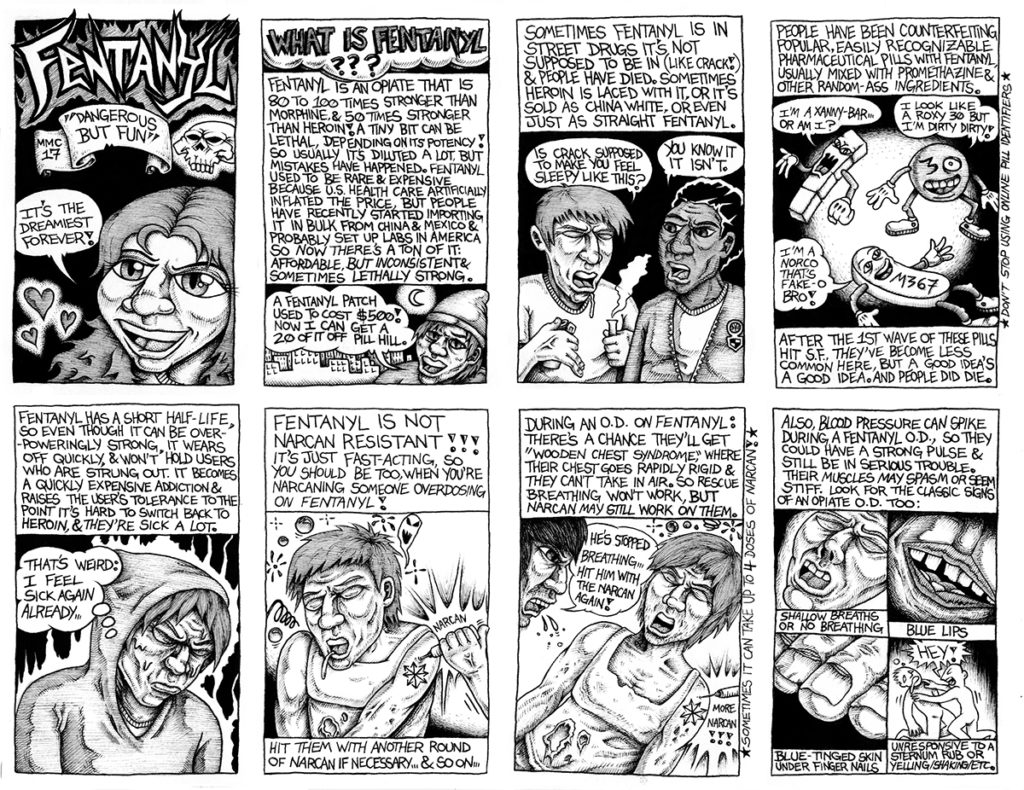by Roadkill and Tee Hoatson
Every year, thousands of people die from opioid overdoses. Fentanyl, however, seems to have a particularly shocking effect. In 2017, 59% of opioid-related deaths involved fentanyl compared to 14.3% in 2010. And this phenomenon isn’t just national, it’s happening here. In 2018, San Francisco had 57 officially recorded fentanyl-related deaths. This is a staggering number—in perspective, that is more than one death each week.
Pharmaceutical fentanyl was created in a lab by Janssen Pharmaceutica back in 1959. While synthetic fentanyl is primarily manufactured in the U.S. and Mexico, China is also a major wholesale supplier of fentanyl products. Fentanyl was originally a controlled substance used only for pain management in chronic illnesses like cancer and distributed for intravenous use only. Fast forward to the 1990s, the drug was introduced to the public for the first time in the form of a patch.
Despite its pharmaceutical origins, fentanyl has hit the streets like many other opioids. On the streets, fentanyl is usually illicitly manufactured, which means the fentanyl people typically use recreationally is completely and totally different from what is prescribed in hospital settings. Illicitly manufactured fentanyl in San Francisco comes in a powder, usually white or light-colored, and it typically contains about 3 – 4 % fentanyl and about 95% a bunch of other drugs, including other opioids, much more powerful fentanyl analogues, stimulants/uppers, and even baking soda or lactose powder.
High overdose rates can be explained by the drug’s strength and the way people usually consume it. Given that pure fentanyl is 50 to 100 times the potency of morphine (and fentanyl analogues can be 100 to 1,000 times stronger than pure fentanyl itself), other drugs are frequently cut with it to reduce costs to distributors. More often than not, buyers are unaware of the true chemical breakdown of what they’re using and end up consuming a higher dose than intended of a more powerful drug than expected—leaving them more vulnerable to overdoses.
In a closer look, we hear from an anonymous local harm reduction expert what Fentanyl use actually looks like and the approaches folks are taking in response to this potentially devastating drug — and these approaches are often based on misinformation.
“The narrative around fentanyl is that it is SO strong that overdose is immediate and unavoidable, that naloxone/Narcan2 won’t work, that it’s so powerful even if you TOUCH fentanyl, you could overdose and die,” they said. “ALL OF THESE THINGS ARE MYTHS AND NOT TRUE.” It’s true that because of its strength, street fentanyl can sometimes be “naloxone-resistant”; media outlets love to capitalize on the shock factor of this label. This does NOT, however, mean that naloxone — Narcan’s generic name — doesn’t work, just that higher-than-usual doses may need to be administered multiple times to reverse an overdose.
Who needs naloxone? Though it’s helpful for any city resident to carry it just in case, our source tells us that “people who use drugs are the most likely to witness overdoses, because they’re there. That’s who we prioritize putting naloxone directly into the hands of, and we do that because it’s evidence-based, with decades of research backing it up. People who use drugs are responding to and reversing over overdoses much more than EMS and SFPD combined in San Francisco, and they do so with far less resources and support.”
When thinking about fentanyl’s overdose potential, discussed above, it’s important to consider an extra layer of nuance. “It’s unpredictable and scary, but it’s not just the drug that creates the danger, it’s the lack of resources surrounding the use: Homelessness, poverty, trauma, chaotic mental health symptoms, stigma, criminalization, sweeps, the constant and unending chaos associated with living in poverty.” Our source continues: “People with money and resources do tons of drugs, all the time, this is a fact — the only difference is the stigma associated with their drugs, the quality of their drugs, and the fact that they have private places (housing) to do them in, so nobody sees it. So we work hard to make sure people have the resources they need to deal with an unpredictable and inconsistent drug supply, which the street drug supply has always been and will always be, as a result of the racist war on drugs, an unregulated drug supply and the criminalization of people who engage in it, often times out of sheer necessity and survival.”
So the ultimate question is: How are we combating fentanyl?
“We aren’t. We can’t. We have no control over the drug supply – nobody does, except for the cartels, and they’re not exactly responding to requests for meetings, right? So we look at what we can control: What information is available to us, who are the experts to consult, what works? The experts are not law enforcement, not doctors. The experts are people who use drugs – they’re actual geniuses who know how drugs work better than anybody, because they’re the ones engaging in the supply and having to navigate the risks every minute of the day. We consult them, and then we amplify their voices to a larger audience, ensuring that what works is being replicated throughout the community.”

If you choose to use fentanyl, or use other drugs that may contain it, here are some concrete tips for using fentanyl as safely as possible:
1.Use less to start.
2.Use slow.
3. Test your drugs whenever possible.
4. Smoke or snort instead of inject.
5. Try not to use alone, or have someone check on you.
6. Carry naloxone and know how to use it.
Footnotes
1. Statistics and facts about fentanyl in this article come from reliable sources that are easy to find and fact check with a quick Google search. They are not formally cited here for stylistic purposes.
2. Naloxone/NARCAN is a medication used to treat, block, and reverse the effects of overdoses, particularly opioid overdoses.

